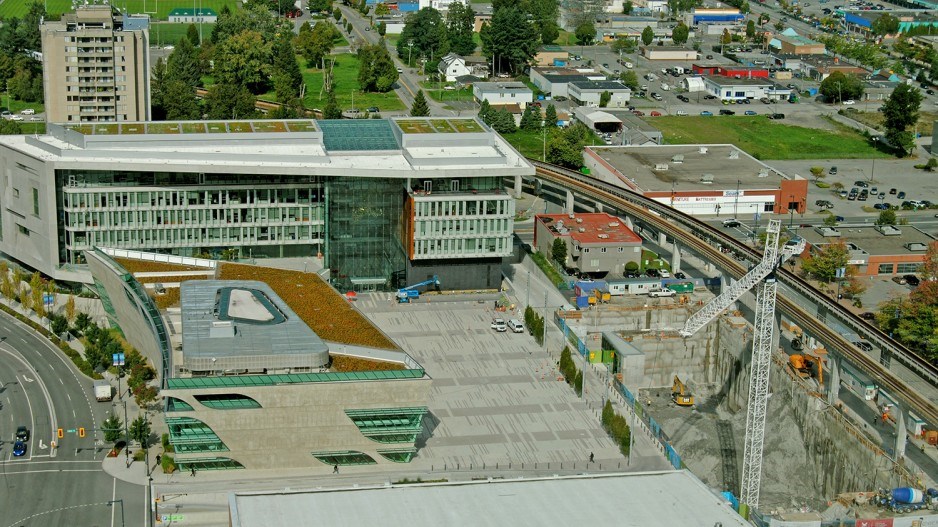Sean Hodgins is standing beside a big hole in the ground. The Century Group president is touring prospective buyers and community leaders through the site that will become 3 Civic Plaza at the end of 2016. The hole will become the parking lot for Surrey’s tallest building, and the tallest south of the Fraser River, with 56 storeys of luxury hotel suites, residential units and three floors of Kwantlen Polytechnic University.
Overtop of Hodgins’ head is the Surrey Central Skytrain station which will receive a major upgrade to accommodate increased ridership starting in 2016. To Hodgins’ right is the brand-new city hall building, designed by internationally renowned Kasian Architecture Interior Design and Planning Ltd. and built at an estimated cost to taxpayers of $150 million. Across a short walkway from that is the Bing Thom Architects-designed Surrey City Centre Library, which opened in 2011. A few kilometres south, by the King George Skytrain station, is a massive multi-phase mixed-use office, retail and residential PCI Developments Corp. complex that will feature approximately 1,700 residential units and roughly 72,000 square feet of commercial space.
As of June of this year, the City of Surrey has a staggering 49 major development projects in various stages of completion in the newly rebranded downtown City Centre. All the big-name developers are there – Bosa Properties, Rize Alliance and Concord Pacific – and everyone wants a piece of the action.
In 2002, Surrey was embarrassingly ranked as the Car Theft Capital of North America. The city was a cast-off bedroom community, a tacked-on afterthought in the big picture of the Lower Mainland. When then-councillor Dianne Watts publicly broke from then-mayor Doug McCallum and ran as an independent mayoral candidate in 2005, she had an ambitious plan for Surrey: not only a rebranding, but a complete foundational overhaul. In 2010, the city’s ambitious Build Surrey program took flight on the winds of economic forecasters pegging the city as a top place to invest. It was also in 2010 that Hodgins and Century Group got on board, starting talks for their three projects in the city.
Now as Surrey is set to elect a new mayor for the first time in close to a decade, the question has to be asked: what will Surrey’s real estate landscape look like 10 years from now in 2024?
“I don’t see any doubt that it will have reached its aspirations of truly becoming a city centre,” said Hodgins. “If you’re talking about Surrey, the aspiration of this becoming a true south-of-the-Fraser downtown, I think that will happen. I think if you look around and see the cranes here, it’s happening. I think it will take the span of those 10 years but I think you will be amazed at what will happen even in five years.”
As 1,200 people a month flood to Surrey, the question is not one of growth, but management of growth. The three mayoral candidates this upcoming municipal election are all varying degrees of pro-business and pro-development, but one theme kept coming up during interviews: continuing the transformation of the city.
“I think continuing with the momentum is really important,” said mayoral candidate Linda Hepner, the city’s former manager of economic development and current councillor. “We have been named, four years in a row, the very best place to invest in Western Canada. And I want that to absolutely be the model of where we’re continuing to go.”
Former mayor McCallum was in office before Surrey took off, from 1996-2005, and said his vision when it comes to real estate and development didn’t change during the nearly 10 years he was out of politics.
“Well, I’m very pro-development, I always have been. I haven’t changed because to me it creates jobs, like plumbers, carpenters. And Surrey’s got such a big population of families and young people that are plumbers and so forth that we need to encourage development. But a balanced development.”
Coun. Barinder Rasode, who broke from the ruling mayor’s party shortly before the election and is running as an independent, wants round-table-like discussions around real estate and development as the city moves forward.
“I think that we have the best opportunity of any city in this country actually, because Surrey is so unique. We are a premier municipality, and we need to treat it like that.”
While the development outlook is nothing but blue skies, the residential market is still recovering from the economic downturn of 2008. Prices of semi-detached homes have risen, but sales have not yet returned to pre-2008 levels. Al Hippsley, owner of Re/Max Colonial Pacific, which sells all over Surrey, said buyers are looking for something new.
“Our product line has shifted to strata, townhouse and condominiums as the entry point into the marketplace. Location, rapid transit and employment really drive the local hot spots.”
Hippsley said there’s another major factor that’s shifted since the housing crash.
“The price of real estate has increased substantially, but the cost to borrow has decreased substantially as well. Most people who have purchased real estate in the last 10 years have not seen an interest rate over 6%. Whereas when I was first selling real estate, 11% was the normal median point.”
One constant face in the local business community is the Surrey Board of Trade’s Anita Huberman. She’s been CEO of the organization for close to a decade now, and said the Build Surrey program was a “legitimate risk,” but one that the city had to do to take itself to the next level.
“If [the Build Surrey program] did not happen, if someone was to look back, we wouldn’t be where we are today. We wouldn’t have the Marriott moving in, we wouldn’t have Century Group investing here. And when someone looks back it will be seen as about the collaboration between all sectors that got us here, and will for the next 10 years.” •
– With files from Patrick Blennerhassett




